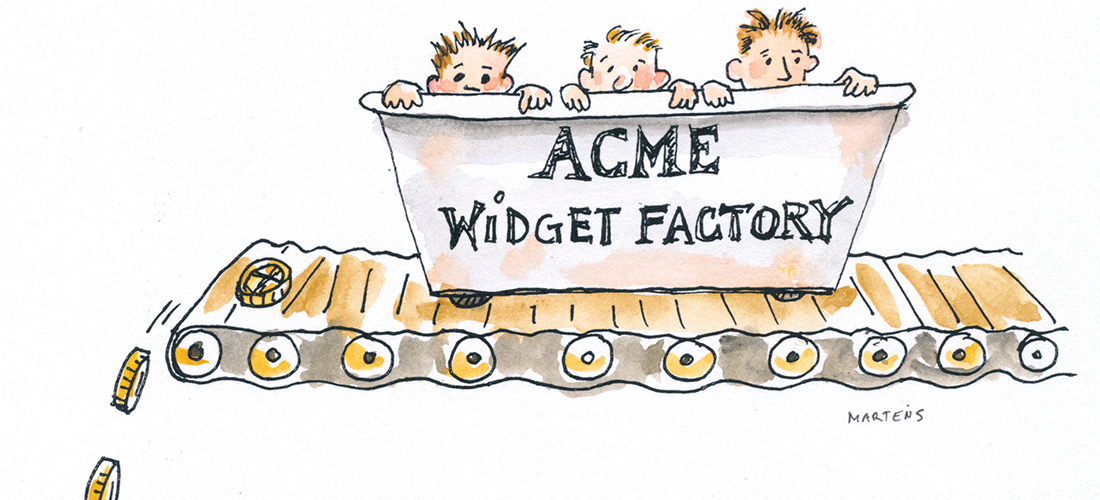
And the learning curve of sweat
By Jim Moriarty
My two older brothers and myself all matriculated at the same institution, the Widget Factory. It’s the place we worked during the summers of our youth. I’m not sure which one of my brothers gave it the name but it’s the only thing we ever called it in our house, and it helped put all of us through places where the learning was advertised as being higher. In the final analysis — which is creeping up on all three of us — I’m not sure if I learned any more from Chaucer than I did from Jocko.
We called it the Widget Factory because functional, mostly unidentifiable, metal objects were manufactured there. You know those doors that open with a push bar? And, the doohickeys that hold the bar on the left and the right? Widgets. Gears don’t shift and forklifts don’t fork without widgets. They are the invisible hand that turns the indispensible cog. In the absence of the mighty widget, life is just a bucket of bolts. It’s true we had no idea what we were making but we were, nonetheless, secure in the knowledge that it served a purpose somewhere, somehow, to someone. And we got paid 10 cents more an hour for doing it on the graveyard shift, 25 cents more if we worked in the foundry.
Jocko ran the acid bath. He had the face of a battered palooka and the body of Haystacks Calhoun, dressed in T-shirts that appeared to be pre-sweat stained and unlaced work boots. You could strop a razor on the toe of either foot. As one might intuit from the name, the acid bath was not without its perils, the evidence of which appeared on most of the exposed portions of Jocko’s flesh. Serious about his craft, he was as territorial as a honey badger. Even the owner of the factory approached Jocko as if he was inviting Luca Brasi over for tea.
Gil worked in the foundry, where they poured the steel at 3,100 degrees. One of the jobs I mastered during my summers was being Gil’s set-up guy, using a two-pronged pitchfork to move ceramic molds from the 1,200-degree oven to the spot where Gil would fill them with molten steel. He once told me he’d grown up in the same neighborhood as Jack Nicklaus and, after Jack hit the big time and Gil hit the foundry, he walked up to the door of Jack’s old house in Columbus, Ohio, and knocked on it just to see how he would be received. He said Jack was still the same old Jack and treated him like the same old Gil. He thought it was the kind of information people with a future beyond the Widget Factory ought to have.
Bob worked in the wax room, but I only addressed him by his last name, preceded by Mr. He owned one of the finest houses on top of a sand dune in one of the swankiest neighborhoods on the lake. On a clear night he could see the Chicago skyline through his picture window. He had successful kids. One was a professional athlete. Sometimes on break, I’d see him out back drinking wine out of a pint bottle. Inside, he sat in front of a cafeteria tray full of tiny wax widgets using a sharp knife and shaky hands to whittle away the residue where the two halves of a mold left an unwanted line. He wasn’t scraping away his dignity; he was holding on to as much of it as he could.
Dennis was the head inspector. Tall and lanky with James Dean hair, he drove a pickup truck as orange as a hunting vest and called me Hippie, combining derision and kindness in the same smoky breath. He had no education to speak of, but he worked meticulously and honestly and showed up on time every day, trusted more by the man who owned the joint to do the right thing than the owner trusted his accountant. That turned out to be prescient, since long after I’d stopped spending my summers there, two people (one was the accountant) who inherited the executive offices from the original owner got led away in handcuffs after they embezzled every nickel that wasn’t welded down. That was the graveyard shift for the Widget Factory, where the evening classes began with a punch clock instead of a bell, and the degree you received was a doctorate in the nobility of work. PS





